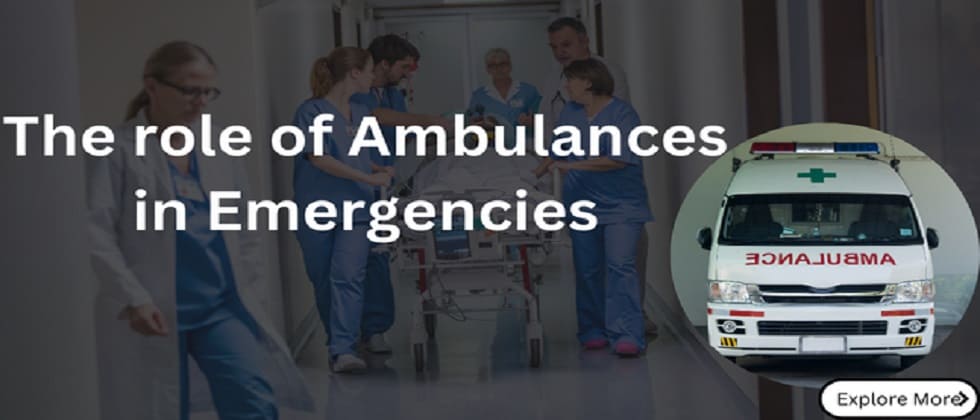Generally, Considering the role of an ambulance service in day-to-day life is very crucial. Knowing steps on how Ambulance Services play their role in saving in different kinds of emergencies is indeed important. If you are also want to know about The role of Ambulances in Emergencies, then in this blog, we have added comprehensive information about it.
So, let’s start-
Types of Emergency on Ambulances Operates
There are different types of emergencies in the world in which an Emergency Ambulance Service Operates
| Type of Emergency | Examples |
| Medical Emergencies | Heart attacks, strokes, respiratory distress |
| Trauma and Injury Cases | Motor vehicle accidents, falls, burns |
| Cardiac Emergencies | Cardiac arrest, chest pain, arrhythmias |
| Obstetric Emergencies | Pregnancy complications, labor complications |
| Pediatric Emergencies | Pediatric respiratory distress, seizures |
| Psychiatric Emergencies | Suicidal attempts, severe psychiatric episodes |
| Environmental Emergencies | Heatstroke, hypothermia, carbon monoxide poisoning |
| Infectious Disease Emergencies | Contagious diseases, outbreaks, severe infections |
| Substance Abuse Emergencies | Drug overdoses, alcohol poisoning |
| Specialized Transfers | Transfers for specialized care, organ transplant transportation |
The role of Ambulances in Emergencies
In each Emergency listed above, there are many roles of Ambulances-
1. Rapid Response
Ambulances are important for providing instant response to emergencies. This ensures that trained medical personnel reach the scene quickly. After reaching out, they can assess and initiate necessary medical help.
2. Immediate Medical Care
Emergency Ambulances are equipped with essential medical equipment. They are also staffed by trained professionals. This allows them to administer immediate medical care. They also stabilize patients and address critical conditions on-site.
3. Patient Transportation
Mainly, Emergency Ambulances play an important role in transporting patients safely and efficiently to healthcare facilities. They do it to ensure that they receive timely and appropriate medical attention. In some cases, medical assistance is required with immediate effect, especially in cases of trauma, cardiac events, or other time-sensitive conditions.
4. Specialized Care En Route
Ambulances come in many types. These types may include Advanced Life Support (ALS) or Critical Care Ambulances. These are capable of providing specialized care during transit. This may include advanced monitoring and life support.
5. Coordination with Emergency Services
Sometimes Ambulance services have to work in coordination with other emergency services. These scenarios have many examples such as fire departments and law enforcement. They have to do it to ensure a complete and organized response to emergencies. Ambulance services contribute to the overall emergency medical system. By doing so, they enhance the chances of positive patient outcomes.
6. Scene Safety and Triage
In Emergency, Ambulance personnel assess the safety of the emergency scene. They do it by taking necessary precautions to ensure the well-being of the patients. Similarly, they do it for the responding medical team. They also monitor patients to prioritize and address the most critical cases first.
7. Communication Hub
In many places, Ambulances serve as a communication hub. They can rely on vital information. On the emergency site & healthcare facilities, They work as communicators. They facilitate efficient coordination and enable hospitals to prepare for incoming patients.
8. Public Health Support
Many times, Ambulances contribute to public health by preventing the spread of infectious diseases. They have protocols for infection control. Their staff is trained to handle cases that may pose a risk to public health. They do it to ensure proper containment and protection.
9. Community Education and Prevention
Ambulance services generally engage in community education and awareness programs. It provide information on basic first aid, CPR, and safety measures. They do it to reduce the occurrence of emergencies. They also empower the community to respond effectively in critical situations.
10. Post-Emergency Support
In the last but not the least, ambulance services may offer post-emergency support. This support can be concluded as connecting patients with appropriate follow-up care, rehabilitation services, or mental health resources. This holistic approach helps patients for the overall well-being and recovery of individuals affected by emergencies.
Conclusion
In summary, we would like to add that, ambulances are crucial in emergencies. They act as quick-response mediators between a crisis and professional medical help. We would also like to add here that, in India, one of the major ambulance services is GoAid Ambulance Services which provides the best of its kind Emergency Services in All Over India.
Ambulances ensure safety at the scene. They also coordinate with other emergency services. They are professional communicators for provide essential information. Beyond the immediate response, they educate communities so they can work as emergency prevention goals too.
FAQs
1. Why is the response time of ambulances crucial in emergencies?
Answer. The response time of ambulances is critical for many reasons. Firstly & mainly, because it determines how quickly trained medical professionals can reach the scene and initiate life-saving help.
2. How do ambulances contribute to patient care during transportation?
Answer. Ambulances are equipped with medical supplies and staffed by trained personnel. This step allows them to provide continuous care during medical traveling. Advanced Life Support (ALS) and Critical Care Ambulances offer specialized care. This care includes monitoring important signs, helping with medicines, and managing complex medical conditions during route to the hospital.
3. Is there a best ambulance service for emergencies?
Answer. Yes, GoAid Emergency Ambulance is a top choice for it. It’s the best because it responds in just 10 minutes. Indeed, it is super fast! GoAid has all kinds of ambulances, like Basic Life Support and Advanced Life Support, to help in approximate all kinds of emergencies.
They make sure the scene is safe. They work well with other emergency services, and take care of patients in the best way.





